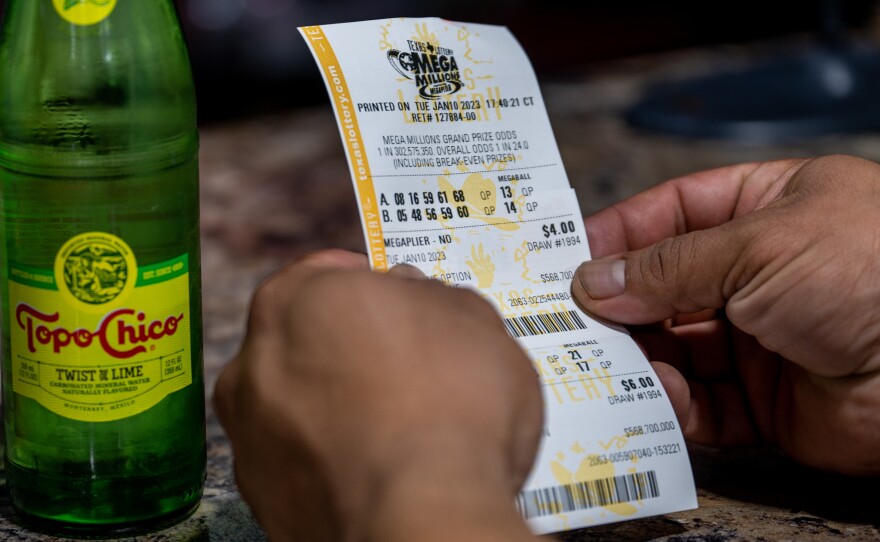Updated March 22, 2024 at 9:08 AM ET
If you like to daydream about what you'd do with a billion-dollar payday, big lotteries are giving you more chances than ever. Eye-popping jackpots are much more common now, fueled by higher interest rates and other factors.
That doesn't mean you have better odds of winning a massive lottery prize than you were 10 years ago. It's less likely, in fact — but that doesn't mean people will stop buying tickets.
"Human beings just fundamentally have a very, very difficult time understanding risk when we have things that are very, very rare," economics professor Victor Matheson of the College of the Holy Cross told NPR.
The what-ifs of sudden wealth are on many Americans' minds again this week, as Mega Millions forecast its jackpot at nearly $1 billion. The next drawing is set for 11 p.m. ET on Friday. If a winner emerges, it would be one of the largest jackpots ever for Mega Millions, which has had five previous jackpots top $1 billion.
Here are five things to know about the way lotteries work, and why organizers are touting mega-jackpots now more than ever:
First, about those billion-dollar paydays
Huge jackpots make for eye-catching headlines — $2.04 billion! $1.337 billion! But while the term "jackpot" might imply a pile of cash waiting to be raked in by a lucky winner, the reality is different.
"It's not accurate at all" to think of someone getting all that money in a sudden windfall, Matheson says. "And it's actually kind of crazy that we've all bought into the framing that the American lotteries have put upon us — even me, the economist who should know better."
When people win the lottery, they get to choose between taking a cash payout or having organizers invest the money in an annuity that will pay them once now, and again for roughly the next 29 years. On the day of the drawing, the actual amount of money at stake might be huge — but it's much smaller than the jackpot.
"What they call the 'advertised jackpot' is the sum of these 30 payments. And that's crazy," Matheson says, adding that lottery winners overwhelmingly opt for the cash payout. But that doesn't stop the lotteries — and yes, the media — from hyping the bigger, more exciting numbers.
Rising interest rates are making jackpots bigger
Lotteries' advertised jackpots are based on annuities, which in turn are based on interest rates. And as interest rates rose sharply over the past year, they took jackpot totals along for the ride.
"To have a $1 billion advertised jackpot today, you need about $500 million in that jackpot pool," Matheson says. "But two years ago, during the depths of the recession from COVID, you would have needed more like $700 million in that pool to actually generate a $1 billion annuity."
The spike in interest rates helps explain why two of the largest-ever lottery jackpots came in 2022. But other factors are also at work.
The lotteries have changed their rules

In the past 10 years or so, lotteries have seen three big changes that made mega-jackpots less rare.
The first big shift came when the two big multi-state lotteries, Mega Millions and Powerball, threw out an old agreement restricting each of them to separate parts of the country.
"They essentially signed a truce," Matheson says. And with all but five U.S. states now operating lotteries, he adds, "what this means is you've got 300 million potential buyers all contributing to that pool."
The second change is simple: prices have doubled. After Powerball raised its tickets from $1 to $2 in 2012, Mega Millions followed suit in 2017, letting money accumulate much more quickly than in the past.
The third shift, Matheson says, is that both lotteries have changed their odds, as they now give players roughly a 1-in-300 million chance of winning.
"The fact that they made it harder to win means it's more likely for the jackpot to roll over" and grow even larger, he says.

People are not great at calculating the odds
Lotteries play on a human desire to dream big. But while humans are good at developing an intuitive sense for how likely risks and rewards are within their own experience, those skills don't translate very well to the immense scope of lotteries.
People's basic misunderstanding about how rare it is to win a jackpot works in the lotteries' favor, Matheson says.
"If people were really, really good at math, no one should be buying lottery tickets," he says.
As an example, he points to that shift in how the two big lotteries work. On an intuitive level, it makes no difference when a lottery goes from offering a 1-in-175 million chance of winning to a 1-in-300 million chance.
"We don't understand that sort of difference, even though mathematically it basically means these billion-dollar jackpots are about twice as common," Matheson says.
Big jackpots shift the lottery's demographics
"One of the major criticisms of lotteries in general is that they prey upon the poor by selling them hope," Matheson says. "And for things like scratch-off tickets, we know that they are predominantly bought by lower income individuals."
A huge jackpot changes the demographic, drawing ticket-buyers from a wide range of incomes. The result, Matheson says, is that lotteries with large jackpots can be seen as "a more progressive lottery ticket option than most of the things that we typically see being sold by lotteries."
For a sign of how that works, consider this: When you walk into a store to buy a lottery ticket with a big payout, you're ignoring other games that bring a higher chance of winning — but that also lack the tantalizing prospect of life-changing wealth.
Matheson sums it up: "The excitement really isn't there, and the dreaming about what you would do [if you won] isn't there with a scratch-off ticket in the same way that it is with a Mega Millions ticket with a gigantic jackpot."
Sure, if you hit it big, you might have to split the prize with other winners. And the actual cash payout will be much smaller than the jackpot — even before the IRS grabs its share. But for most of us, that's not the point.
"It really is a purely entertainment product," Matheson says of the lottery. "As soon as people start thinking of it as an investment product, that's a problem because it's an investment with a huge negative return on average."
Copyright 2024 NPR. To see more, visit https://www.npr.org. 9(MDAzMjM2NDYzMDEyMzc1Njk5NjAxNzY3OQ001))






